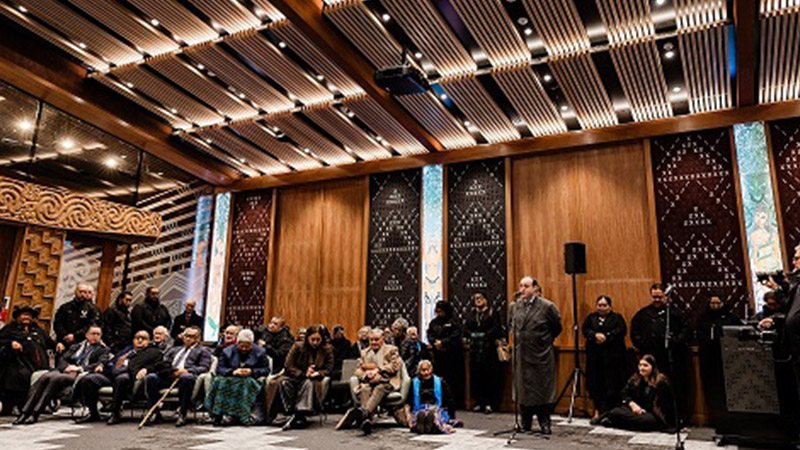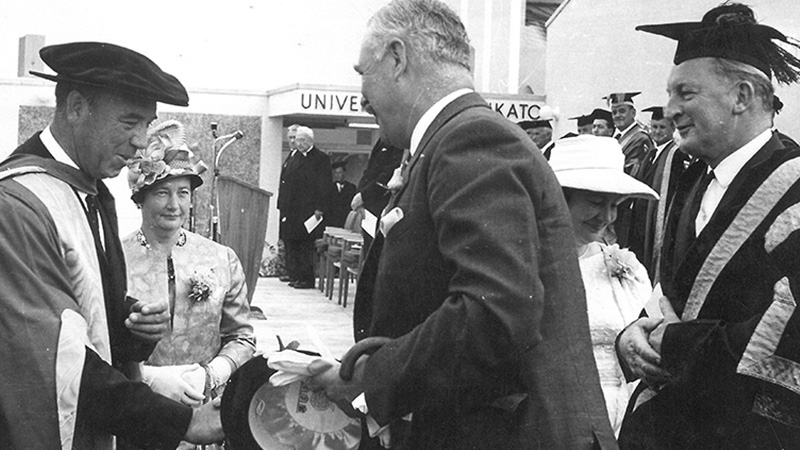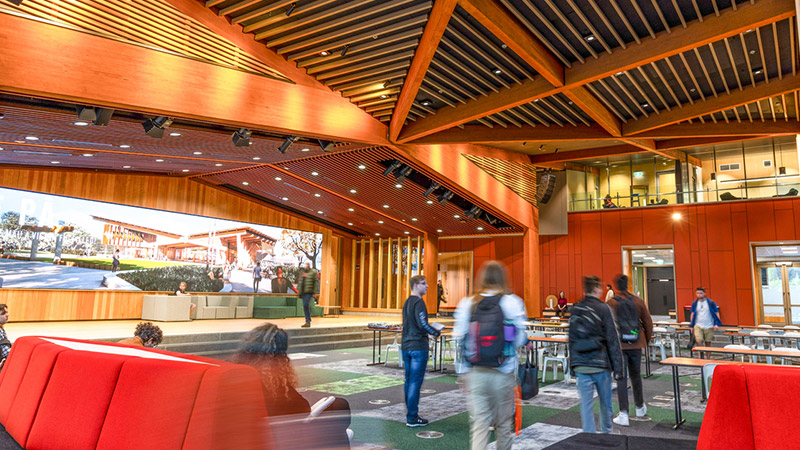Evolution of the University Campuses

A Legacy of Innovation and Growth
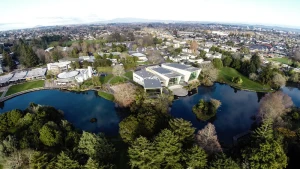 Situated on 65 hectares of sprawling land that was once a research farm known as Ruakura No 5 the design of the University of Waikato campus was first guided by architect John Blake-Kelly.
Situated on 65 hectares of sprawling land that was once a research farm known as Ruakura No 5 the design of the University of Waikato campus was first guided by architect John Blake-Kelly.
Opened in 1964, its design and layout followed the Brutalist architecture principles of the era, and though functional, its design lacked cohesion. As the campus has developed over the past 60 years however, a campus master plan is reshaping the University towards a blend of civic, social, cultural, community and academic experiences, breathing life into our mission – Ko Te Tangata, For the People.
We now host an impressive array of facilities set amidst tranquil gardens, lakes, and sports grounds. Our student halls that help students transition between living, learning, and leisure are now home to more than 1,000 students who enjoy the supportive home away from home environment fostered on campus.
The Gallagher Academy of Performing Arts houses our concert chamber with near-perfect acoustics and has cemented itself as a pivotal place in Hamilton’s cultural and performing arts scene. It is also home to Te Pae Kōkako – The Aotearoa New Zealand Opera Studio (TANZOS) and regularly attracts both national and international talent.
Our Student Centre - Te Manawa, which houses the Library and provides a central study space for students was opened in 2011, and the new centre of our Hamilton campus, The Pā, opened in 2023 and has helped to connect the Hamilton campus, giving expression to our cultural identity.
The growth of our campus over the past 60 years has also seen our expansion into Tauranga, a commitment that was cemented with the opening of our Tauranga campus in 2019. As technology has removed geographical boundaries, we have had significant growth in our on-line delivery both nationally and internationally, and we have also seen the international expansion of our University, with the growth of three off-shore campuses and the attraction of international students from over 80 countries around the world.
Campus Vision for 2037
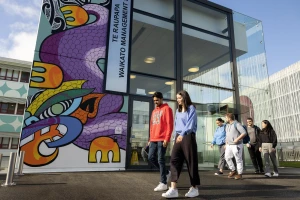 Our relationships and connection to our community have driven our campus development over the past 60 years and our campus master plan towards 2037 will continue to lead this development to blend civic, social, cultural, community and academic experiences.
Our relationships and connection to our community have driven our campus development over the past 60 years and our campus master plan towards 2037 will continue to lead this development to blend civic, social, cultural, community and academic experiences.
Our long-term campus vision is for a living campus that supports a rewarding study and work-life balance and is responsive to a diverse range of student and staff needs, providing staff and students with a greater choice over where, when, and how they learn, research, socialise, play, and work.
A campus that reflects our cultural identity, celebrates, and enhances the natural landscape and exemplifies the University as a centre for excellence in learning, research, and innovation breathing life into the University mission – Ko Te Tangata. For the People, the foundation of our identity.
Halls of Residence
The existence of the University is for our students. Alongside teaching and learning spaces, the University's commitment to student welfare was manifested in the establishment of Halls of Residence. The oldest of five student residences on the University campus is College Hall, originally built for Teachers College students. It was also the first hall to receive a major upgrade in 2012 and 2013, part of a long term, multi-million-dollar plan to modernise all the University’s halls.
Many of the University’s development projects have been supported by generous philanthropic donations, not least of these from the DV Bryant Trust, which has had a long association with the University. The Trust also contributed to the Academy of Performing Arts, The University recreation centre, the Don Llewellyn Sport Pavillion, and other academic initiatives. One of the Trust’s first endeavours was Bryant Hall, opened on 12 March 1971. In 2003, the Trust gifted the residence to the University and established residential scholarships for students in financial need. More than 350 students have been supported with a residential scholarship since it was introduced.
Since the development of our early halls there has been demand for more self-catered student accommodation and the University has responded to this with our Silverdale Road Apartments in Hamilton and our Selwyn Street Studios in Tauranga. In Hamilton, each apartment has its own kitchen, bathroom, and queen bed with a living/study space while the Tauranga studios include shared social spaces that provide stunning views across the harbour.
Gallagher Academy of Performing Arts
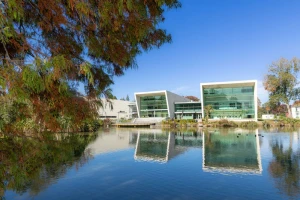 Opened in 2001 by then Prime Minister Helen Clark, the Gallagher Academy of Performing Arts holds a pivotal place in Hamilton’s cultural and performing arts landscape.
Opened in 2001 by then Prime Minister Helen Clark, the Gallagher Academy of Performing Arts holds a pivotal place in Hamilton’s cultural and performing arts landscape.
Since the University’s inception, developments on the campus were in response not only to delivering superior teaching and learning facilities but to creating community connection. In the 1990s one of the first priorities of the University’s Capital Works Planning Group was the building of a performing arts centre. In 1995 a development manager was appointed to drive the project forward.
As architectural designs were confirmed funding support was provided by Gallagher Group, WEL Energy Trust, the DV Bryant Trust, New Zealand Lotteries, Lion Foundation, Perry Foundation, Morton Estate Wines, and the Waikato Raupatu Lands Trust along with smaller staff and community donations.
New Zealand Opera Soprano, Dame Malvina Major, acted as a Patron during the fundraising and development of the building and eventually accepted a role as a senior fellow to teach singing and act as an ambassador for the University. She was later instrumental in the formation of Te Pae Kōkako - The Aotearoa New Zealand Opera Studio (TANZOS).
The Gallagher Academy of Performing Arts has been pivotal in attracting large community events to the campus. In 2011 renewed sponsorship from Gallagher reaffirmed the Academy's pivotal role in Hamilton's cultural landscape.
Te Manawa: The Heart of Student Life
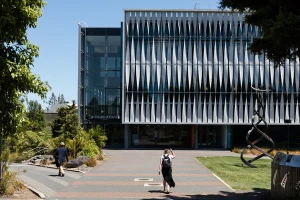 The metamorphosis of the old University Library into Te Manawa – The Student Centre in 2011 marked a shift in our campus rejuvenation. Its development saw a major addition to the library building which, since the University’s inception, had grown from one small room with workspace in the University’s very first building, A Block, in 1964, to a specifically designed four storey space opened in 1976.
The metamorphosis of the old University Library into Te Manawa – The Student Centre in 2011 marked a shift in our campus rejuvenation. Its development saw a major addition to the library building which, since the University’s inception, had grown from one small room with workspace in the University’s very first building, A Block, in 1964, to a specifically designed four storey space opened in 1976.
Te Manawa recreated the Library into multifunctional hub. It was symbolic of the University’s vision for future campus developments, including places to meet, cafés, shops, relaxation spaces, and a central point for student services on campus. Te Manawa was awarded 5 stars for sustainability for its use of photovoltaic cells, self-monitoring lighting and energy efficient heating. Its aluminium cladding was designed to resemble a cloak symbolising both mana and protection from the elements.
Tauranga Campus Development
The University has been active in the Bay of Plenty since the 1990s, when we first formed an alliance with Toi Ohomai Institute of Technology. Our first cohort of Bay of Plenty students graduated in Tauranga in 2001.
Our aim was always to provide a world-class, university-led campus in Tauranga to fill the missing link in the network of tertiary campuses in the Bay of Plenty. Opened in 2019, the $60 million Tauranga campus houses a multipurpose space that features communal study spaces, a 24-hour computer lab, central atrium (The Hub), science labs, lecture theatre and classrooms. Te Manawaroa, also includes a multipurpose space used for overnight noho stays, and a generous ātea (open courtyard).
As with many University developments it was made possible through the support and drive of the region and the University’s close connections with its community. Key funders included Tauranga City Council, Bay of Plenty Regional Council and TECT, who all saw the need to enhance the range of qualifications and study options available to students in the Bay of Plenty.
The Pā
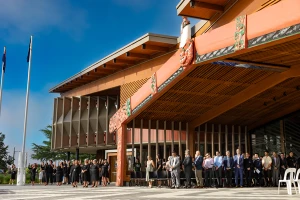 The opening of The Pā on the University’s Hamilton campus by Kīngi Tūheitia in 2023 represented a major step in the evolution and growth of the University.
The opening of The Pā on the University’s Hamilton campus by Kīngi Tūheitia in 2023 represented a major step in the evolution and growth of the University.
The Pā is the largest single capital project in the University’s history and its development reflects our commitment to an integrated and accessible campus that includes social interaction, hospitality, and culture.
At the heart of The Pā, is the University’s new wharenui, Ko Te Tangata, the name carried over from the University’s motto, developed for the University by the late Professor Te Wharehuia Milroy in the 1990s. The motto is now elevated as the name of the new wharenui and revitalised through The Pā’s cultural narrative and artworks that link it to the history and heritage of the site and to the long-standing connections with the Kīngitanga, Waikato-Tainui and iwi communities throughout the University’s extended catchment
The complex also includes Te Āhurutanga: The Student Hub, the new year-round home of campus life for students. Te Āhurutanga features social and learning spaces, a food court, and a dedicated space for tauira Māori.
The University’s original building, ‘A Block’, was also fully renovated and integrated into the new building and included in the complex is also a staff club and executive offices.
In October 2023, the University held its first graduation ceremonies in The Pā, realising a long-held vision for a mana-enhancing space able to cater for on campus graduations.
A Global University
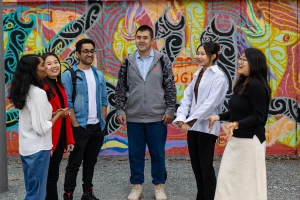 As the University has evolved, technology has removed geographical boundaries and the University is now a truly global institution. We are connected internationally through numerous research, teaching, and mobility partnerships; we deliver education offshore and we attract top international academic staff as well as international students from more than 80 countries.
As the University has evolved, technology has removed geographical boundaries and the University is now a truly global institution. We are connected internationally through numerous research, teaching, and mobility partnerships; we deliver education offshore and we attract top international academic staff as well as international students from more than 80 countries.
The University was the first New Zealand university to receive Chinese Ministry of Education approval to fully deliver degrees in China. The first cohort of students started at the University’s Joint Institute with Hangzhou City University, formally Zhejiang University City College (ZUCC), in late 2017, and enrolments continue to increase across the three Waikato degree programmes being offered. The University also has joint partnership with the National Economics University (NEU) in Hanoi where we deliver undergraduate programmes including our Bachelor of Business with majors in Supply Chain Management and Digital Business.
We also contribute to undergraduate Engineering programme delivery at Hebei University of Science and Technology (HEBUST) – Shijiazhuang, China. Students can transfer to the University of Waikato and complete 180 points under BSc to gain a degree from both institutions.
In 2023 we launched a new Joint Programme with Hainan University in China where students study towards a Bachelor of Science (Computer Science). Students can complete their studies without leaving China and earn bachelor’s degrees from both the University of Waikato and Hainan University.
